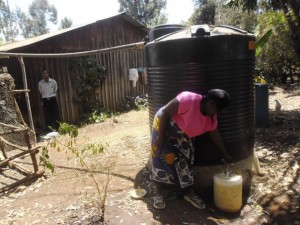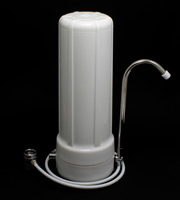Arsenic in our Drinking Water
by Deborah Blum
The baby with the runny nose, the infant with a stubborn cough — respiratory infections in small children are a familiar family travail. Now scientists suspect that these ailments — and many others far more severe — may be linked in part to a toxic element common in drinking water.
The element is naturally occurring arsenic, which swirls in a dark, metalloid shimmer in soil and rock across much of the United States and in many other countries. It seeps into groundwater, but because the contamination tends to be minor in this country, for many years its presence was mostly noted and dismissed by public health researchers.
They’ve changed their minds. Long famed for its homicidal toxicity at high doses, a number of studies suggest that arsenic is an astonishingly versatile poison, able to do damage even at low doses. Chronic low-dose exposure has been implicated not only in respiratory problems in children and adults, but in cardiovascular disease, diabetes and cancers of the skin, bladder and lung.
Trace amounts in the body interfere with tumor-suppressing glucocorticoid hormones, studies show, which is one reason that arsenic exposure has been linked to a range of malignancies. Arsenic also interferes with the normal function of immune cells. It damages lung cells and causes inflammation of cells in the heart.
Researchers first became aware of these problems in so-called hot spot countries like Bangladesh, where arsenic levels in water can top 1 part per million. Decades ago, public health agencies there sought to replace microbe-contaminated surface water with well water. Only later did geological surveys reveal significant aquifer contamination from bedrock arsenic.
Scientists now report health risks at lower and lower levels of exposure in that country. In July, researchers at the University of Chicago found that residents of Bangladesh chronically exposed to arsenic at a mere 19 parts per billion showed signs of reduced lung function. At levels of 120 p.p.b. or higher, their ability to take in oxygen resembled that of long-term smokers.
“Bangladesh is unfortunately a living laboratory for the health effects of arsenic,” said Habibul Ahsan, the lead author of the study and director of the Center for Cancer Epidemiology and Prevention at the University of Chicago.
Dr. Ahsan, a native of Bangladesh, is one of the organizers of a long-term study of arsenic and health in that country, which now has 30,000 people enrolled. In 2010, he reported that 24 percent of all deaths from chronic disease in his study population could be attributed to drinking arsenic-contaminated well water.
“We need to take arsenic exposure very seriously,” Dr. Ahsan said.
That seems to be today’s watchword. Researchers have begun a widespread re-evaluation of arsenic as a public health threat not only in water, but in the food supply. The Food and Drug Administration recently set a limit of 10 p.p.b. for arsenic in apple juice, and the agency is now evaluating the risks posed by foods like rice, which tend to pick up arsenic from the soil. At the request of the Environmental Protection Agency, the National Academy of Sciences has begun an intensive review of arsenic risks. The academy study group is chaired by Joseph Graziano, a professor of environmental health sciences at Columbia University who researches the link between arsenic in drinking water and cognitive deficits in children.
Researchers also are taking a much closer look at drinking water, from Southwestern states like Nevada, where wells sometimes contain arsenic at more than 500 p.p.b., to the upper Midwest and New England, where a belt of arsenic-infused bedrock taints aquifers in stretches from the coast of Maine to a point midway through Massachusetts. Water in parts of the Central Valley of California, America’s breadbasket, has been found to be tainted with arsenic as well.
While municipal water suppliers are required to meet the E.P.A.’s safety standard of 10 p.p.b. for arsenic in drinking water, no such regulation exists for private wells. Nationwide, researchers say, about 13 million people get drinking water from private wells with arsenic levels above the federal standard.
And studies here are beginning to show a pattern of harm not unlike that seen in Bangladesh. One study of private wells in Michigan, tainted with arsenic in the 10 to 100 p.p.b. range, found increased mortality rateslinked to everything from diabetes to heart disease. Another focusing on cardiovascular disease in small communities is due to be published next week.
At Dartmouth College, the New Hampshire Birth Cohort Study is following women through pregnancy into parenthood, comparing the health of children in families drinking from private wells with those who rely on municipal water supplies.
In a study published in July in Environmental Research, researchers measured arsenic exposure during pregnancy and then tracked respiratory infections in infants up to four months of age. The higher the arsenic exposure in the mother, the scientists found, the greater the number of respiratory infections in their infants, especially ones that required a visit to the doctor or prescription medicine.
The results describe a pattern similar to that seen in Bangladesh, where scientists have found a greater than 50 percent increase in severe lower respiratory infections among infants of mothers with high levels of arsenic, compared with those with the least exposure.
“We were surprised to find the connection so visible at the lower exposures seen here,” said Margaret Karagas, a Dartmouth epidemiologist and the senior author of the study. The Dartmouth pregnancy cohort study has also found a link between low-level exposure to arsenic and low birth weight in infants.
“If people have private wells, they need to have them tested for arsenic,” she said. “You want to know what’s in your water.” Meanwhile, Dr. Karagas and other experts are looking at the ways that arsenic in the food supply might add to an individual’s cumulative exposure.
“We need to start looking at all the sources,” Dr. Ahsan said.
Source: New York Times Health/Science.
Pure Water Gazette Fair Use Statement
More information: Arsenic.





![pwanniemedium[1]](http://purewatergazette.net/blog/wp-content/uploads/2012/05/pwanniemedium1-246x300.jpg)






